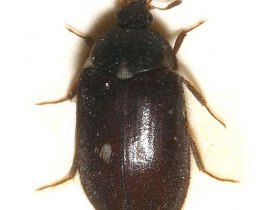Professional Pest Control & Wildlife Management
Fur Beetle
The Fur Beetle Attengenus pellio is fairly large textile damaging insect. It has two white dots on its otherwise black body, so unsurprisingly its also known as the Two Spotted Carpet Beetle.
The adult beetles themselves feed on flower nectar, its larvae however can chew through furs and wollen products.
If you have an infestation of Fur beetles and would like some help contact us here
-
Risks
Fur beetle larvae can damage textiles of organic origins, leathers and wollens are particulary at risk. The larvae are also commonly found in dried foods such as flour, spices etc.
-
Treatment
Treatment for Fur Beetle infestations begins with first identifying the source. Adults will often enter a home on the wing flying in through an open window, if you are finding significant numbers of adults on your window sills their is likely an infestation somewhere inside.
Removing any infested items and spraying a residual insecticide in the area and along the floor/wall junctions, then all cracks and crevices should bring the problem under control quiet quickly.
Fur beetles are often found in lofts where they will have been attracted to birds nests, dead rodent carcusses and dead insects.
-
Life Cycle
Fur beetles are great flyers. Adults seek out suitable nesting locations which will have a source of protein for the larvae to feed on when hatched. Fur beetles are common in lofts where they infest birds nests, dead rodents and live on dead insects - cluster fly. The female lays her eggs in batches eventually laying as many as 100. When they hatch the larvae are tiny - 0.5mms. As they grow they will moult six times leaving behind the old skin which is often the first sign of an infestation.
The larvae stage in life cycle of the Fur Beetle may take two years to complete, pupating in the spring adults emerge to begin the lifecycle again.
- False Widow Spider Removal
- Cluster Fly help
- The trouble with fleas?
- Mole Catching in Suffolk
- Rats in the Garden
- Wasp Nest Control
- Rats in your chicken Coop
- Anaphylaxis
- Bee Swarms
- Honey Bee Relocation
- Rare Breed Poultry
- Pest Control with Birds of Prey
- Un-marked vehicles available
- Rabbiting with Ferrets
- Myxomatosis
- Poll-Tex Mesh
- Honorary Member Russell Wallis
- Free Rabbit Control


